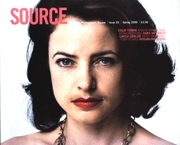Us-Versus-Them
by John Mullin
Issue 22 Spring 2000
View Contents ▸
View photographs from: Republicans ▸
Irish folk love funerals; a chance to gather together, demonstrate that all-important sense of community, and afterwards remember the departed with a drink in the hand and a lump in the throat. No one, though, takes more pride in burying their fallen than republicans.
There is, of course, the grief factor: some mother's son, and all that. The Troubles are a predominantly working-class affair, and the volunteers are well-known in their districts, though often more as a husband or worker or pool player than an IRA member. So many who attend a republican funeral are paying their respects to the wee boy who used to play in the street who grew into a television repairman with three kids rather than the terrorist. Such of those people would say they abhorred violence if asked, but they are rather ambivalent when it's one of their own.
An example: just one business owner refused to shut down his shop in Dundalk, Co Louth, on the day of IRA hunger striker Bobby Sands' funeral. He had problems for years. For that was a tumultuous event which was about far more than the question of armed violence. It was, in short, about us against them. Those attending a republican funeral know that, and, whatever their individual views, are proud to make that statement. Commemorations, rallies and memorial services to those who long ago passed into legend are popular for much the same reason. The sense of occasion, though, is heightened, for the grave-faced participants perishing without coats are the true believers.
Such ceremonies represent a crucial form of communication; to each other and also to the world outside: all the more so when draconian legislation on both sides of the Irish border denied republicans what Margaret Thatcher memorably described as the oxygen of publicity. They perhaps unwittingly became, during the worst days, a vital component in conveying unified defiance. A reminder, in these days of the manipulative Sinn Féin media machine, that it is only in the last half dozen years we have been able to welcome the voices of Gerry Adams and Martin McGuinness into our homes. Now there is no hiding place, except the off switch.
Pity the jobbing actors who used to voice-over their pronouncements. The changes in policy in the British and Irish jurisdictions after the 1994 ceasefire must have substantially slashed their income.
Tony O'Shea's photographs capture the important truths of republican commemorations: the weeping lad almost too young to act as pall-bearer; the rarely worn ties somehow out of place on rural necks; and, above all, the pride in leathered, serious faces. Even the teenagers at the monument to three IRA victims of the SAS at Strabane, Co Tyrone, have imbued the overpowering sense of respect. He captures a sense of an unbroken people, unsophisticated yet crushingly impressive.
The photograph at Loughall mirrors the us-versus-them war, often fought out in Northern lreland's countryside. To their friends and family, the IRA volunteers were martyrs. To the security forces, scum who got what was coming to them. So contrast the grimly set jaw of the eldest pall-bearer as he carries the coffin past a barn with the RUC on the other side of the fence in a ploughed field. That the officers are in no set formation somehow makes their presence more threatening. And that the mourner is steadfastly ignoring them underlines his contempt.
One interesting aspect of republican martyrs is how they are accepted into the mainstream after a decent passage of time. Fianna Fáil may be happy to hold a commemoration for IRA hardliner Liam Lynch. Had he been active during the Troubles rather than in the civil war, rest assured Albert Reynolds would have been elsewhere. Hypocrisy? Perhaps.
Other articles mentioning Tony O'Shea:
Other articles on photography from the 'Political' category ▸






